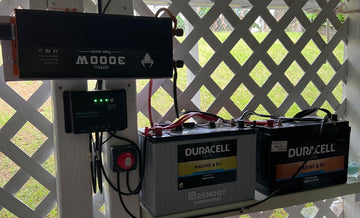When you embark on a new journey in your RV, it's more than a simple adventure; it comes with an important responsibility: to utilize one of nature's richest resources - the sun. By integrating solar power into your vehicle's energy system, you'll have a constant supply of energy and be free from the constraints of a campground.
In addition, a solar panel alone is not good enough to capture solar energy to turn it into electricity for your journey, but a very important tool is needed- a solar charge controller. In this comprehensive guide, we'll take an in-depth look at the features of RV solar charge controllers, shed light on the key factors to consider, and help you choose between the many options available. Then, let's begin the journey to RV freedom!
What is an RV Solar Charge Controller

The RV Solar Charge Controller, an important device used in caravan solar power systems, is placed between the solar panel and the battery bank. The solar panel is used to capture sunlight, the battery bank is used to store energy, and the charge controller is used to regulate the flow of electricity from the solar panel to the caravan battery bank. Its main function is to prevent overcharging of the battery by controlling the voltage and current of the solar panel.
How an RV Solar Charge Controller works
Regulating Solar Panel Output: Solar panels generate direct current (DC) electricity, and their output voltage can vary depending on factors like sunlight intensity. The solar charge controller regulates and optimizes the voltage and current from the solar panels to match the requirements of the RV's battery bank.
Battery Charging: The solar charge controller manages the charging process by monitoring the battery's state of charge (SOC) and adjusting the charging parameters accordingly. It ensures that the batteries receive the appropriate charging current and voltage to maximize their lifespan and efficiency.
Battery Protection: Solar charge controllers provide various protective features for the batteries, such as overcharge protection, over-discharge protection, and short circuit protection. These features help prevent damage to the batteries and ensure their safe operation.
System Monitoring: Some RV solar charge controllers come with built-in monitoring capabilities, allowing users to track important system parameters like solar panel output, battery voltage, charging current, and overall system performance. This monitoring helps users understand the energy flow and make informed decisions about their RV's power usage.
RV solar charge controllers are available in different types, including Pulse Width Modulation (PWM) and Maximum Power Point Tracking (MPPT) controllers.
PWM controllers are more affordable and suitable for smaller solar systems, while MPPT controllers are more efficient and can extract maximum power from the solar panels, making them ideal for larger or more complex RV solar setups.
Overall, an RV solar charge controller plays a crucial role in managing and optimizing the charging process from solar panels to the RV's battery bank, ensuring efficient power utilization and extending the lifespan of the batteries.
Things to Consider When Choosing an RV Solar Charge Controller
There are several key factors you should consider when choosing the best RV solar charge controller:
Voltage and Current Rating
Make sure that the controller you choose has a voltage and current rating that can match the requirements of your solar panels and battery bank. The voltage rating of the controller should be compatible with the maximum output voltage of the solar panels and be able to provide the appropriate charging current to the battery bank.
Power Capacity
Ensure that the controller's power capacity can meet your system requirements. Consider the rated power of the solar panel and your expected charging needs, and choose a controller with sufficient power capacity.
Charging Method
Solar charge controllers typically use pulse width modulation (PWM) or maximum power point tracking (MPPT) charging methods. MPPT controllers provide higher charging and energy conversion efficiencies under varying lighting conditions and are especially good at tracking the power of solar panels. Therefore, if your budget allows, choosing a controller with an MPPT function may be a better choice.
Temperature and Environmental Resilience
If you plan to use your solar charge controller in harsh environmental conditions (e.g., hot or cold areas), make sure the controller you choose has good temperature and environmental resilience. This includes proper thermal design, dust and water resistance, and the ability to operate at high or low temperatures.
Functionality and protection
Consider whether the controller has the required functionality and protection features, such as overcharge protection, over-discharge protection, short circuit protection, reverse current protection, etc. These features can help protect the system and the battery and improve system reliability and safety.
Manufacturer's reputation and support
Check the reviews and customer feedback about the manufacturer to understand its product quality, reliability, and after-sales support. Choose a manufacturer with a good reputation and reliable after-sales support to ensure that technical support and services are available when needed.
Other key factors
- Display and Monitoring: Some controllers are equipped with displays or monitoring interfaces that can show information such as the power, current, and voltage of the solar panels as well as the charging status of the battery bank.
- Adjustable Voltage Setpoint: This feature allows you to customize the charging voltage setpoint to match your battery type.
- On/Off Switch: This is a convenient option to stop charging without removing the fuse from the battery.
- Dry Camp/Shore Power Switch: This feature allows you to toggle between battery charge setpoints, which is useful for a variety of scenarios such as wilderness camping, shore power, or storage.
Choose the size of solar charge controller for an RV
Selecting the size of your RV Solar Charge Controller can be done by following these steps:
- Determine the solar panel output: First, determine the total power of the solar panels you plan to install. This can be determined by looking at the wattage of the solar panels or their current and voltage. For example, if you have four 100W solar panels, the total power of the solar panels will be 400W.
- Determine the voltage of the battery pack: Find out the voltage of your motorhome's battery system. Common options are 12V, 24V or 48V. Make sure the regulator is compatible with your battery pack voltage.
- Calculate the maximum current the solar panels can produce: Amps = total solar panel power/battery bank voltage. For example, if you have 400W solar panels and a 12V battery, current = 400W/12V = 33.34A. Make sure that the amperage rating of the controller is equal to or greater than the current you have calculated.
- Consider future expandability: If you plan to increase the number or power of your solar panels in the future, consider choosing a charge controller with higher capacity and adaptability for future needs.
- Understand charge controller types: Research the different types of charge controllers, such as PWM and MPPT controllers. Understand their features, performance, and applicability. Select the type that best suits your needs
- Research and compare different makes and models: Carefully research and compare different makes and models of charge controllers. Check the manufacturer's specifications and recommendations for performance and applicability.
Best MPPT Solar Charge Controller for RV: 60A 12V/24V

- Compatible with 12V and 24V systems
- Dual USB output ports
- Multiple Battery Adaptations
- Six built-in safety protections
- Maximizes solar power
- 24-month warranty and lifetime technical support
FAQs
Q: Do you need a solar charge controller for an RV?
A: Yes, solar charge controllers are recommended for RV solar systems to regulate the current between the solar panels and the batteries to prevent excessive convenience or overcharging of the batteries.
Q: Is the MPPT charge controller better than PWM?
A: Not necessarily, they have various advantages and disadvantages. There are scenarios where the advantages of MPPT are not obvious and it's still expensive, so PWM is more appropriate
Q: Is a 400-watt solar panel enough for an RV?
A: In addition to residential properties, 400 W panels are well-suited for powering RVs, boats, and other off-grid devices.
Q: How much solar is to run RV AC?
A: This depends on several factors, including the capacity of the air-conditioning unit, the efficiency of the system, the duration of air-conditioning use, and the hours of sunlight. Air-conditioning units in RVs usually consume a lot of electricity, and running them on solar power alone is a challenge due to the high energy demand.

















